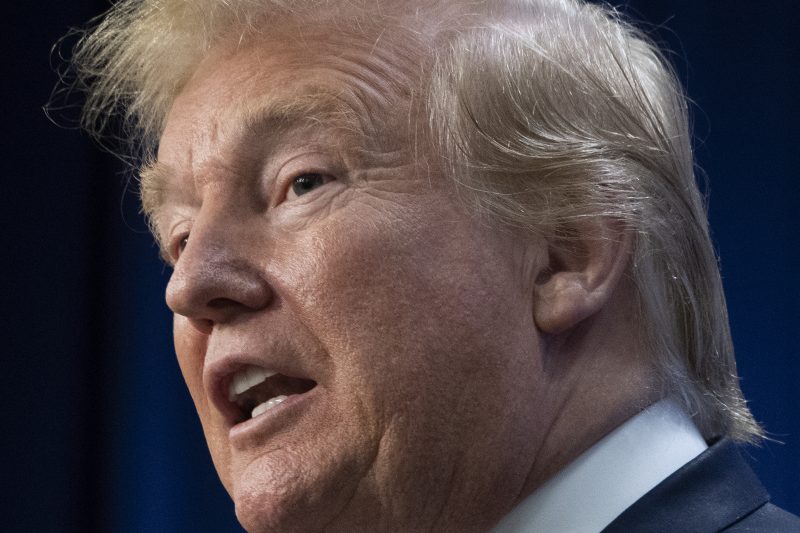Chinese negotiators still eye US trip despite Trump tariffs
Donald Trump’s announcement came as a major Chinese delegation is expected to arrive in Washington for the latest round of talks to end the trade war between the world’s two biggest economies (Jim WATSON)
Beijing (AFP) – China said Monday it still plans to send negotiators to the United States for trade talks even after President Donald Trump vowed to raise tariffs later this week, a threat that sent stock markets into a tailspin.
Trump upped the ante as negotiators prepared to meet in Washington on Wednesday for what has been billed as a last-ditch round of negotiations to reach a deal or revive the trade war.
“The Trade Deal with China continues, but too slowly, as they attempt to renegotiate. No!” Trump wrote on Twitter on Sunday.
The US leader said tariffs on $200 billion in Chinese goods would increase from 10 percent to 25 percent on Friday. The United States is already applying custom duties of 25 percent on $50 billion in Chinese high-tech products.
Trump also renewed a threat to impose tariffs on all Chinese imports to the US — worth $539.5 billion last year.
Despite Trump’s tweetstorm, Chinese foreign ministry spokesman Geng Shuang said a Chinese team was “currently preparing to go to the US for negotiations” — but he did not say when or whether top negotiator Liu He would lead the delegation.
Geng said “positive progress” has been made in 10 rounds of high-level negotiations and that the whole world was watching.
“We still hope that the US can work together with China, walk shoulder to shoulder and strive for a mutually beneficial win-win agreement on the basis of mutual respect,” he said at a regular press briefing.
“This is not only in line with the interests of the Chinese side but also the interests of the US and the international community,” Geng said.
The Wall Street Journal had earlier reported that China was considering cancelling the talks.
“China shouldn’t negotiate with a gun pointed to its head,” the newspaper quoted a person briefed on the matter as saying, using a line Beijing has repeatedly said in the past.
Chinese shares sank following the tweets, with Shanghai stocks tumbling by more than five percent, their worst day in more than three years. Hong Kong plunged by 2.90 percent while Shenzhen ended down 7.38 percent.
The two sides have imposed tariffs on $360 billion in two-way trade since last year. But Trump and Chinese leader Xi Jinping agreed to a truce in December to refrain from further escalation.
The US side visited Beijing last week for talks that Treasury Secretary Steven Mnuchin described as “productive”.
Trump and Xi would likely hold a summit to seal any deal.
Trump says he wants to reduce the huge US trade deficit with China, which in 2018 totalled $378.73 billion with services trade included.
Besides a greater opening of the Chinese market to US goods, Trump is pressing for structural changes such as Beijing ending its alleged practice of forcing US companies that operate in China to share their technology.
Trump is also demanding that China halt intellectual property theft and subsidies to state-owned companies.
The US president has insisted throughout the process that he will not accept a watered-down trade accord. And his administration warned recently that trade talks could not simply go on forever.
– Resumption of trade war? –
For now, the Trump administration insists that the trade war has left the US economy unscathed, unlike the Chinese economy, which last year posted its slowest growth in nearly 20 years.
Trump asserted that so far the tariffs he imposed on Chinese goods “are partially responsible” for the robust US economy, which in the first quarter grew at an annual rate of 3.2 percent.
But many economists are worried about the longer term effects on the US economy.
Some US manufacturers who import Chinese products that are subject to tariffs are already complaining of higher costs. And economists warn that US consumers will end up paying more for everyday items.
So far, the Chinese side in the talks has agreed for China to buy more US products, mainly in the farm and energy sectors.
But one major obstacle to reaching a final deal continues to be a mechanism for enforcing any accord that is agreed upon.
The Trump administration says it has seen promises and commitments ignored in the past, so this time it will not sign a deal unless it features measures that will allow Washington to verify that China is keeping its word.
Beijing is pressing for the US to lift the tariffs it has imposed, which Washington is evidently not willing to do.
Vice President Mike Pence said Friday that Trump is prepared to impose even more tariffs if no deal is reached.
“The manner in which tariffs would come off is going to be a part of the enforcement mechanism and all of that is the subject of negotiations as we talk,” Pence told CNBC.
Trump’s chief negotiator, Robert Lighthizer, told the Senate Finance Committee in March that America must keep open the option of raising tariffs on Chinese imports as a way to be sure China complies with the trade deal the two sides are working to complete.
Disclaimer: Validity of the above story is for 7 Days from original date of publishing. Source: AFP.


